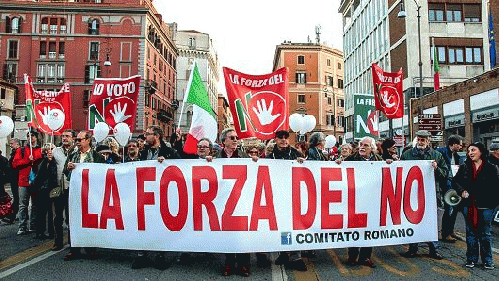It has been called "a bigger risk than Brexit"-- the Italian banking crisis that could take down the eurozone. Handwringing officials say "there is no free lunch" and "no magic bullet." But UK Prof. Richard Werner says the magic bullet is just being ignored.
On December 4, 2016, Italian voters rejected a referendum to amend their constitution to give the government more power, and the Italian prime minister resigned. The resulting chaos has pushed Italy's already-troubled banks into bankruptcy. First on the chopping block is the 500 year old Banca Monte dei Paschi di Siena SpA (BMP), the oldest surviving bank in the world and the third largest bank in Italy. The concern is that its loss could trigger the collapse of other banks and even of the eurozone itself.
There seems little doubt that BMP and other insolvent banks will be rescued. The biggest banks are always rescued, no matter how negligent or corrupt, because in our existing system, banks create the money we use in trade. Virtually the entire money supply is now created by banks when they make loans, as the Bank of England has acknowledged. When the banks collapse, economies collapse, because bank-created money is the grease that oils the wheels of production.
So the Italian banks will no doubt be rescued. The question is, how? Normally, distressed banks can raise cash by selling their non-performing loans (NPLs) to other investors at a discount; but recovery on the mountain of Italian bad debts is so doubtful that foreign investors are unlikely to bite. In the past, bankrupt too-big-to-fail banks have sometimes been nationalized. That discourages "moral hazard" -- rewarding banks for bad behavior -- but it's at the cost of imposing the bad debts on the government. Further, new EU rules require a "bail in" before a government bailout, something the Italian government is desperate to avoid. As explained on a European website called Social Europe:
The EU's banking union, which came into force in January 2016, prescribes that when a bank runs into trouble, existing stakeholders -- namely, shareholders, junior creditors and, sometimes, even senior creditors and depositors with deposits in excess of the guaranteed amount of 100,000 -- are required to take a loss before public funds can be used . . . .[The problem is that] the subordinated bonds that would take a hit are not simply owned by well-off families and other banks: as much as half of the 60 billion of subordinated bonds are estimated to be owned by around 600,000 small savers, who in many cases were fraudulently mis-sold these bonds by the banks as being risk-free (as good as deposits basically).
The government got a taste of the potential backlash a year ago, when it forced losses onto the bondholders of four small banks. One victim made headlines when he hung himself and left a note blaming his bank, which had taken his entire 100,000 savings.
Goldman Sachs Weighs In
It is not just the small savers that are at risk. According to a July 2016 article titled "Look Who's Frantically Demanding That Taxpayers Stop Italy's Bank Meltdown":
The total exposure of French banks and private investors alone to Italian government debt exceeds 250 billion. Germany holds 83.2 billion worth of Italian bonds. Deutsche bank alone has nearly 12 billion worth of Italian bonds on its books. The other banking sectors most at risk of contagion are Spain ( 44.6 billion), the U.S. ( 42.3 billion) the UK ( 29.8 billion) and Japan ( 27.6 billion).. . . All of which helps to explain why banks and their representatives at the IMF and the ECB are frantically demanding a no-expenses-spared taxpayer-funded rescue of Italy's banking system.
It could also explain why Goldman Sachs took it upon itself to propose a way out of this dilemma: instead of buying Italian government bonds in their quantitative easing program, the ECB and the central bank of Italy could buy the insolvent banks' nonperforming loans.
As observed in a July 2016 article in The Financial Times titled "Goldman: Italy's Bank Saga -- Not Such a Big Deal," Italy's NPLs then stood at 210bn, and the ECB was buying 120bn per year of outstanding Italian government bonds as part of its quantitative easing (QE) scheme. The author quoted Goldman's Francesco Garzarelli, who said, "by the time QE is over -- not sooner than end 2017, on our baseline scenario -- around a fifth of Italy's public debt will be sitting on the Bank of Italy's balance sheet." Bringing the entire net stock of bad loans onto the government's balance sheet, he said, would be equivalent to just nine months' worth of Italian government bond purchases by the ECB.
Buying bank debt with money generated by the central bank would rescue the banks without cost to the taxpayers, the bondholders or the government. So why hasn't this option been pursued?
The Inflation Objection
Perhaps the concern is that it would be inflationary. But UK Prof. Richard Werner, who invented the term "quantitative easing" when he was advising the Japanese in the 1990s, says inflation would not result. In 2012, he proposed a similar solution to the European banking crisis, citing three successful historical precedents.
One was the US Federal Reserve's quantitative easing program, in which it bought $1.7 trillion in mortgage-backed securities from the banks. These securities were widely understood to be "toxic" -- Wall Street's own burden of NPLs. The move was highly controversial, but it worked for its intended purpose: the banks did not collapse, the economy got back on its feet, and the much-feared inflation did not result. Werner says this was because no new money entered the non-bank economy. The QE was just an accounting maneuver, an asset swap in the reserve accounts of the banks themselves.
(Note: You can view every article as one long page if you sign up as an Advocate Member, or higher).






